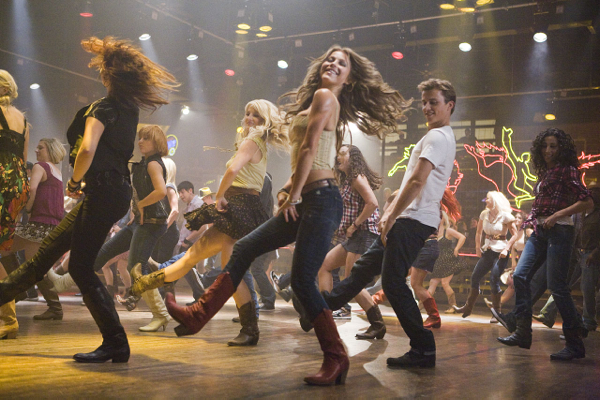Movie review by Greg Carlson
At first glance, Craig Brewer’s remake of the massively successful 1984 musical-drama “Footloose,” seems like an unusual choice for the director of the adult-oriented “Hustle & Flow” and “Black Snake Moan.” Brewer’s public adoration for Herbert Ross’ coming of age quasi-fable includes an anecdote that the teenager recorded and memorized the entire audio track of the film when he figured out how to connect his VCR to his boombox, and the slavish act of reconstruction on display is certainly a testament to the moviemaker’s reverence for the film that catapulted Kevin Bacon to stardom following a string of mostly disappointing features.
Very little in the new edition substantively improves on the old model, although the smartest change sees Ren McCormack’s move to Bomont necessitated by his mother’s death. Original screenwriter Dean Pitchford receives co-script credit with Brewer, and a significant amount of dialogue is recycled verbatim. This less-is-more approach, which doesn’t extend to the intensified displays of choreography packed into the update, arguably retains the suspension-of-disbelief earnestness revolving around a public dance ban and the irrepressible youth who quote from the Bible in an effort to change the law. No matter how corny, teen movies can be fertile ground for expressions of generational clash, and the game of tractor chicken, less successfully rewritten as figure-eight school bus roulette, invokes the primacy of “Rebel without a Cause.”
Brewer announces his fidelity to the source material when Ren uncovers a dusty vinyl copy of Quiet Riot’s “Metal Health” and instantly pulls up “Bang Your Head (Metal Health)” on his iPod, even though Brewer banishes most other traces of contemporary digital life. From Ren’s yellow Volkswagen Beetle to Ariel’s red cowboy boots, nostalgia dominates the design of the 2011 “Footloose.” Kenny Wormald’s Ren and Julianne Hough’s Ariel may be able to out-hoof Bacon and Singer, but neither one can do as much dramatic damage. Hough’s apple-cheeked preacher’s daughter never hints at the reserves of wild-child hellraising attained by the often overlooked Singer.
The new “Footloose” uses fewer of the original’s signature tracks than the 1998 stage version that debuted on Broadway to mixed reviews, but familiar hallmarks include the “teaching Willard to dance” montage accompanied by Deniece Williams’ number one “Let’s Hear It for the Boy” as well as the “Dancing in the Sheets” drive-in sequence, transformed and sampled into a sweaty, bouncing, racially-mixed grind by David Banner called “Dance the Night Away.” Set in Georgia, Brewer’s Southern roots open the door for African American influences to be more robustly implemented, but unfortunately, only a few roles have been reassigned to actors of color.
Aside from the musical tweaks, Brewer also ditches the book-burning scene, which functioned as a turning point in the humanization of John Lithgow’s grieving father. Viewers in 1984 were provided with several opportunities to recognize that the strict clergyman was, at heart, a reasonable man. The remake doesn’t ignore this angle entirely, but Dennis Quaid’s Shaw Moore ends up with less screen time than his predecessor. It’s fun to imagine what Bacon might have done in the part of the reverend, but alas, neither he nor Lori Singer makes a cameo appearance.
